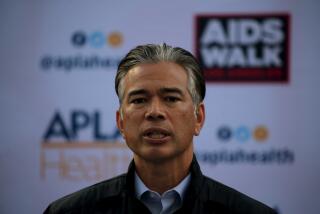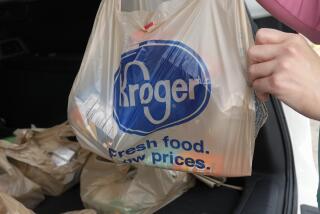Pensions Concerned About Risk, Return on Investment : KKR’s Backers Take Dim View of Hostile Deals
NEW YORK — Managers of pension funds that are the backbone of Kohlberg Kravis Roberts & Co.’s leveraged buyout machine give kudos to the aggressive investment firm but are concerned that its $20.3-billion bid for RJR Nabisco Inc. teeters on hostility.
Despite the potential for astronomic returns, several fund managers said Monday that they would have to reconsider their commitment to the New York-based firm if the top management of the consumer products giant ultimately failed to embrace the deal.
Last week, Kohlberg Kravis launched a $90-a-share tender offer for Atlanta-based Nabisco that is contingent upon approval by the company’s board, leaving the investing public to ponder just where things stand.
Nabisco’s top managers, who put their company in play by announcing that they were considering taking the company private for $75 a share, or about $17 billion, are not expected to be able to match Kohlberg Kravis’ offer, but they are still resisting its bid.
$5.6-Billion War Chest
Either offer would produce the biggest leveraged buyout by far, and Kohlberg Kravis was widely viewed as ready to fight to maintain its position as the premier buyout firm, raising the question of whether it might be willing to make its first hostile takeover bid. Negotiations collapsed last week in an attempt to share the deal between Kohlberg Kravis and Shearson Lehman Hutton Inc., Nabisco’s primary financial partner.
With a $5.6-billion war chest that can be “leveraged” tenfold by borrowing, Kohlberg Kravis is backed by roughly 70 investors that range from the Salvation Army to the endowment funds of Harvard and Yale to the pension funds of New York, Wisconsin, Minnesota and other states. Among the corporations whose pension funds have pledged some assets are Coca-Cola, Georgia-Pacific and United Technologies.
Minnesota’s Board of Investment, which invests state employees’ pension money, committed about $200 million to Kohlberg Kravis on the basis that the firm would participate only in “friendly” deals--those supported by the target’s board.
“If they change their procedures, we’d have to review” the state’s commitment, said Howard Bicker, the board’s executive director.
“KKR has always said they are going to do friendly deals, and from what we understand, although this has been painted differently in some of the press, this deal still is basically on a friendly basis,” he added.
No Trends
In the brief span of years Kohlberg Kravis has been investing in risky leveraged buyout deals, Bicker said, returns have averaged 30% to 40% annually, enough to fill any pension manager with glee.
But industry observers note that these buyout funds have been in existence too few years to establish a definitive trend. “There isn’t a long track record--you can’t look at 60 years of data” like you can with the stock market, noted Richard Brody, an investment consultant in the Atlanta office of Hewitt Associates, a pension consulting firm.
In the five years during which the leveraged buyout has blossomed, the business environment has been particularly favorable to this type of transaction, Brody said.
In a leveraged buyout, roughly 90% of an acquisition is paid for with debt, which is then reduced by selling off parts of the company or by dramatic cost cutting that boosts cash flow. Kohlberg Kravis is expected to provide only about $2 billion in cash--most from its leveraged buyout fund--to finance the Nabisco deal.
Pension fund managers note that investments in buyout funds or in the buyouts themselves are extremely risky. Most pension funds allocate 5% to 10% of their total assets to what Brody described as “riskier and more esoteric forms of investment,” including real estate, venture capital, oil and gas exploration and leveraged buyouts.
Greater Volatility
A further problem is that there is little liquidity with leveraged buyouts. It is just not that easy to get money out while the buyout wizards are still trying to sell off a company’s assets.
John Donaldson, controller at Avon Products Inc., said his company’s pension fund has about $10 million invested with Kohlberg Kravis. While the firm’s “historic pattern of returns makes it worth looking at, the volatility is much greater than with general equities,” he said.
“We would rather they not do hostile deals as a matter of (our) corporate conscience, but we do believe KKR does not do hostile deals,” he said.
Given that premise, however, Donaldson noted that any time a money manager such as Kohlberg Kravis does “something out of the ordinary, something that departs from their historic activity, we would review” the investment.
Some corporations that consider themselves potential takeover targets might shy from investing in leveraged buyout funds simply because they would not want to support an industry that one day might threaten them, some experts speculated.
The California Public Employees Retirement System, which has $47 billion in assets and is the nation’s largest public pension fund, has just begun a study on whether it should allocate funds for leveraged buyouts.
Patricia Pinkos, an investment officer in Sacramento, said that as part of the study, which is to be completed in the next few months, “we will look at the hostile transaction. I assume we would not want to participate in that.”
Many investment houses have established leveraged buyout funds, but Kohlberg Kravis is by far the most recognizable name in the game.
“KKR may be perceived as the safe name,” Brody said. “It may be easier to convince a board of directors that this is the appropriate route (for investing) if it’s a name they’re going to recognize.”
More to Read
Inside the business of entertainment
The Wide Shot brings you news, analysis and insights on everything from streaming wars to production — and what it all means for the future.
You may occasionally receive promotional content from the Los Angeles Times.










